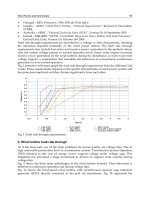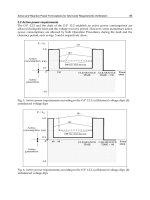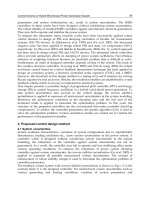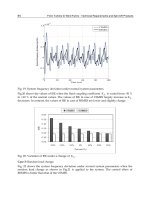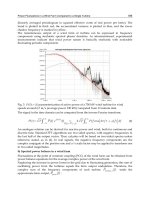From Turbine to Wind Farms Technical Requirements and Spin-Off Products Part 16 docx
Bạn đang xem bản rút gọn của tài liệu. Xem và tải ngay bản đầy đủ của tài liệu tại đây (150.96 KB, 5 trang )
From Turbine to Wind Farms - Technical Requirements and Spin-Off Products
214
external group helping to coordinate and mediate generally improves the chances of
reaching a successful agreement (Noble, 2000).
4.2.3 Legislated
In the case where finding a market solution for multi-use in the offshore setting is not possible,
a legislative prescription can still attain desired policy goals of spatial efficiency in the ocean
area. The use of mandates, subsidies, tariffs, and other policy tools can change the incentives of
the current economic environment to make the multi-use concept economically viable.
As there is a growing focus on coastal zone management and the efficient and equitable use of
coastal resources in the EU, US, and elsewhere (Krause et al., 2003, Lutges and Holzfuss, 2006;
RICRMC, 2010), policy makers may find policy instruments as a palatable solution for
achieving policy goals. Mariculture can offer expanded employment opportunities to rural
peripheral regions and displaced fishermen in the area of a wind energy facility, and
potentially make wild harvest fisheries more productive if mariculture areas act as nurseries
for wild fish (Mee, 2006). Indeed, multi-use layering of economic activities can maximize the
value of offshore resources while reducing conflict between stakeholder groups. Promoting a
multi-use concept would not be an uncommon step; regulators have already shown that they
are comfortable with using legislation to spur growth in the offshore wind energy industry.
A clear, coherent, and stable regulatory framework is a bare minimum when firms make
financial decisions in the inherently risky offshore marine environment. Managers need to
be able to predict with some certainty the expected outcomes of changes in strategy, be it an
internal decision or the decision to form an external alliance. Carroll et al. (1988) have found
that fragmentation in the structure of State decision making is shown to lead to more
elaborate and costly inter-organisational networks. The decision to actively foster
cooperation on a multi-use concept should largely be dependent on market conditions, and
the potential social benefits available from multi-use facilities.
5. Conclusion
The discussion thus far has attempted to frame the potential cooperation in a multi-use
setting in the context of the broader social, political, and economic spheres, while also
illuminating the perceptions and characteristics of the particular industries themselves. It
appears clear that uncertainty and risk are large components of this discussion, and
naturally were brought up by survey respondents. The likelihood and form of collaboration
in the near future will be shaped by how well this risk and uncertainty is addressed.
It is apparent that the orchestration of a multi-use concept such as an integrating wind
energy and mariculture will be difficult. First results indicate that practical multifunctional
use of offshore areas requires technical and economic feasibility as a basic prerequisite to
assure that both offshore wind farm operators and mariculturists will support a multi-use
concept. This suggests that as more information emerges on the economic and technical
viability of this, it will be clearer if this is a practical approach towards rationalizing marine
stewardship in the offshore setting. Concurrent to this, it will fall to policy-makers to
sanction the range of options for how such a facility might be managed. The discussion here
is meant to enlighten the debate going forward on the relative merits of various
management alternatives, while also illuminating the motivations for cooperation from a
business standpoint.
Perceived Concerns and Advocated Organisational Structures of
Ownership Supporting ‘Offshore Wind Farm – Mariculture Integration’
215
6. References
Badjeck, M.C. (2008). Vulnerability of coastal fishing communities to climate variability and
change: implications for fisheries livelihoods and management in Peru. PhD Thesis,
University of Bremen, 227.
Baugh, M. (2009). Insurance: Supporting the Wind Energy Sector, In: The Offshore Wind
Revolution: Making Sense of the Opportunity, Morrison, R. (Ed.), 63-72, Reuters Project
Finance International.
Beamish, P. (1994). Joint Vetures in LDCs: Partner Selection and Performance. Management
International Review, 34, 2, 60-74.
BMU/Stiftung Offshore Windenergie (2007) Offshore wind power deployment in Germany.
Federal Ministry for the Environment, Nature Conservation and Nuclear Safety
(eds).
Bond, R., Kapondamgaga, P.H., Mwenebanda, B., Yadav, R.P.S., Rizvi, A. (2007). Monitoring
the livelihood platform: reflections on the operation of the Livelihood Asset-Status
Tracking method from India and Malawi. Impact Assessment and Project
Appraisal, 25, 4, 301-315.
Bridger, C., & Costa-Pierce, B. (2003). Open Ocean Aquaculture: From Research to Commercial
Reality. Proceedings of the 2003 World Aquaculture Society Conference, Baton
Rouge, LA.
BSH. (2008). Wind farms. Bundesamt für Seeschifffahrt und Hydrographie (Federal
Maritime and Hydrographic Agency). Hamburg/Rostock, Germany. (Available
March 2008 at )
Buck, B. H. (2002). Open Ocean Aquaculture und Offshore Windparks. Eine
Machbarkeitsstudie über die multifunktionale Nutzung von Offshore-Windparks
und Offshore-Marikultur im Raum Nordsee. Reports on Polar and Marine Research,
Alfred Wegner Institute for Polar and Marine Research, Bremerhaven, Germany.
Buck, B.H. (2007). Experimental trials on the feasibility of offshore seed production of the
mussels Mytilus edulis in the German Bight: Installation, technical requirements and
environmental conditions, Helgoland Marine Research 61, 87-101.
Buck, B. H. & Buchholz, C. M. (2004). The Offshore-Ring: A New System Design for the
Open Ocean Aquaculture of Macroalgae. Journal of Applied Phycology, 16, 355-268.
Buck, B. H. & Buchholz, C. M. (2005). Response of Offshore Cultivated Laminaria saccharina
to Hydrodynamic Forcing in the North Sea. Aquaculture, 250, 95-122.
Buck, B. H. & Krause, G. (2011) Integration of Aquaculture and Renewable Energy Systems.
Encyclopedia of Sustainability Science and Technology. In press
Buck, B. H., Berg-Pollack, A., Assheuer, J., Zielinski, O. & D. Kassen. (2006). Technical
Realization of Extensive Aquaculture Constructions in Offshore Wind Farms:
Consideration of the Mechanical Loads, Proceedings of the 25th International
Conference on Offshore Mechanics and Arctic Engineering, OMAE 2006 : presented
at the 25th International Conference on Offshore Mechanics and Arctic
Engineering, 4-9 June 2006, Hamburg, Germany / sponsored by Ocean, Offshore,
and Arctic Engineering, ASME. New York, NY : American Society of Mechanical
Engineers, pp 1-7.
From Turbine to Wind Farms - Technical Requirements and Spin-Off Products
216
Buck, B. H., Krause, G., Michler-Cieluch, T., Brenner, M., Buchholz, C., Busch, J., Fisch, R.,
Geisen, M., & Zielinski, O. (2008). Meeting the Quest for Spatial Efficiency: Progress
and Prospects of Extensive Aquaculture within Offshore Wind Farms. Helgoland
Marine Research, 62, 3, 269-281.
Buck, B. H., Ebeling, M. W., & Michler-Cieluch, T. (2010). Mussel cultivation as a co-use in
offshore wind farms: potential and economic feasibility. Aquaculture Economics
and Management 14(4): 1365-7305.
Carroll, G., Goodstein, J., & Gyenes, A. (1988). Organisations and the State: Effects of the
Institutional Environment on Agricultural Cooperatives in Hungary. Administrative
Science Quarterly, 33, 2, 233-256.
Dahlke, V. (2002). Genehmigungsverfahren von Offshore-Windenergieanlagen nach der
Seeanlagenverordnung. Natur und Recht, 24, 472-479.
EWEA. (2009a). Operational Wind Farms in Europe: End 2009. Report by the European Wind
Energy Association.
EWEA. (2009b). Oceans of Opportunity: Harnessing Europe’s Largest Domestic Energy Resource.
Report by the European Wind Energy Association.
Fukuyama, F. (1995). Trust: The Social Virtues and the Creation of Prosperity. Hamish Hamilton,
London, UK.
Gee, K. (2010). Offshore Wind Power Development as Affected by Seascape Values on the
German North Sea Coast. Land Use Policy, 27, 2, 185-194.
Gierloff-Emden, H.G.R. (2002). Wandel der Umwelt der See- und Küstenlandschaft der
Nordsee durch Nutzung von Windenergie. Mitteilungen der Österreichischen
Geographischen Gesellschaft, 144, 219-226.
Grandori, A. & Soda, G. (1995). Inter-firm Networks: Antecedents, Mechanisms and Forms.
Organisational Studies, 16, 2, 183-214.
Granovetter, M. (1985). Economic Action and Social Structure: The Problem of
Embeddedness. American Journal of Sociology, 91, 3, 481-510.
Griffin, R. & Krause, G. (2010). Economics of Wind Farm-Mariculture Integration. Working
Paper, Department of Environmental and Natural Resource Economics, University
of Rhode Island.
Henderson, B. (1974). The Experience Curve Reviewed vs. Price Stability. Perspectives, No.
149, Boston Consulting Group.
Inkpen, A. (2008). Knowledge Transfer and International Joint Ventures: The Case of
NUMMI and General Motors. Strategic Management Journal, 29, 447-453.
James, M.A. & Slaski, R. (2006). Appraisal of the Opportunity for Offshore Aquaculture in
UK Waters. Report of Project FC0934, commissioned by Defra and Seafish from
FRM Ltd., 119 pp.
Johnson, S. & Houston, M. (2000). A Reexamination of the Motives and Gains in Joint
Ventures. Journal of Financial and Quantitative Analysis, 35, 1, 67-85.
Krause, G., Buck, B.H., Rosenthal, H. (2003). Multifunctional Use and Environmental
Regulations: Potentials in the Offshore Aquaculture Development in Germany.
Proceedings of the Multidisciplinary Scientific Conference on Sustainable Coastal
Zone Management “Rights and Duties in the Coastal Zone”, 12–14 June 2003.
Stockholm, Sweden.
Perceived Concerns and Advocated Organisational Structures of
Ownership Supporting ‘Offshore Wind Farm – Mariculture Integration’
217
Kumar, M.V. (2007). Asymmetric Wealth Gains in Joint Ventures: Theory and Evidence.
Finance Research Letters, 4, 19-27.
Lutges, S. & Holzfuss, H. (2006). Integrated Coastal Zone Management in Germany:
Assessment and Steps Towards a National ICZM strategy. German Federal
Ministry for the Environment, Nature Conservation, and Nuclear Safety, 12 pp.
McGuinness, T. (1994). Markets and Managerial Hierarchies. In: Markets, Hierarchies, and
Networks, Thompson, G. et al. (Eds.), 66-81, Sage, London, England.
Mee, L. (2006). Complementary Benefits of Alternative Energy: Suitability of Offshore Wind
Farms as Aquaculture Sites. Report of Project 10517, commissioned by Seafish, 36
pp.
Michler, T. & Kodeih S. (2007). Offshore wind energy. Integration of Mariculture in Offshore
Wind Farms. Coastline Magazine, 16, 1, 8 pp.
Michler-Cieluch, T., Krause, G. (2008). Perceived Concerns and Possible Management
Strategies for Governing ‘Wind Farm–mariculture Integration’. Marine Policy, 32, 6,
1013-1022.
Michler-Cieluch, T., Krause, G., & Buck, B. (2009a). Reflections on Integrating Operation and
Maintenance Activities of Offshore Wind Farms and Mariculture. Ocean & Coastal
Management, 52, 57-68.
Michler-Cieluch, T., Krause, G., & Buck, B. (2009b). Marine Aquaculture within Offshore
Wind Farms: Social Aspects of Multiple Use Planning. GAIA, 18, 2, 158-162.
Nielsen, B. (2010). Strategic Fit, Contractual, and Procedural Governance in Alliances.
Journal of Business Research, 63, 682-689.
Noble, B. (2000). Institutional Criteria for Co-management. Marine Policy, 24, 1, 69-77.
Osborn, R. & Baughn, C. (1990). Forms of Interorganisational Governance for Multinational
Alliances. The Academy of Management Journal, 33, 3, 503-519.
Osborn, R. & Hagedoorn, J. (1997). The Institutionalization and Evolutionary Dynamics of
Interorganisational Alliances and Networks. The Academy of Management Journal, 40,
2, 261-278.
Pauly, D., Christensen, V., Guénette, S., Pitcher, T.J., Sumaila, R.U., Walters, C.J., Watson, R.,
& Zeller, D. (2002). Towards Sustainability in World Fisheries. Nature, 418, 689–695.
Rhode Island Coastal Resources Management Council. (2010). Rhode Island Ocean Special
Area Management Plan. 1856 pp.
Robinson, D. (2008). Strategic Alliances and the Boundaries of the Firm. The Review of
Financial Studies, 21, 2, 649-681.
Snyder, B. and Kaiser, M. (2009). A Comparison of Offshore Wind Power Development in
Europe and the U.S.: Patterns and Drivers of Development. Applied Energy, 86,
1845-56.
Tiedemann, A. (2003). Windenergieparke im Meer - Perspektiven für den
umweltverträglichen Einstieg in eine neue Großtechnologie. In: Lozán J, et al. (eds).
Warnsignale aus Nordsee & Wattenmeer: Eine aktuelle Umweltbilanz.
Wissenschaftliche Auswertungen, Hamburg, 142–148.
Williamson, O. (1979). Transaction-Cost Economics: The Governance of Contractual
Relations. Journal of Law and Economics, 22, 2, 233-261.
From Turbine to Wind Farms - Technical Requirements and Spin-Off Products
218
Williamson, O. (1981). The Economics of Organisation: The Transaction Cost Approach.
American Journal of Sociology, 87, 548-577.
Williamson, O. (1996). The Mechanisms of Governance. Oxford University Press, ISBN 0-19-
507824-1, New York, New York.
Wirtz, K.W., Tol, R.S.J., & Hooss, K.G. (2003). Mythos “Offene See”: Nutzungskonflikte im
Meeresraum. In: Lozan, L. et al (eds). Warnsignale aus Nordsee & Wattenmeer.
Eine aktuelle Umweltbilanz. Wissenschaftliche Auswertungen, Hamburg, 157–160.



